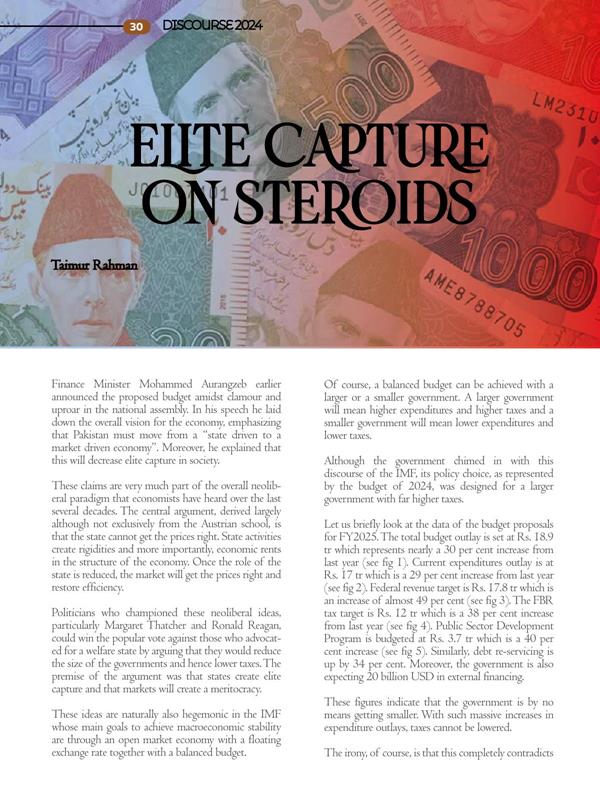
Pakistan Institute of Development Economics
- Home
Our Portals
MenuMenuMenuMenuMenuMenuMenu - ResearchMenuMenuMenuMenuMenuMenuMenu
- Discourse
- The PDR
- Our Researchers
- Academics
- Degree Verification
- Thesis Portal
- Our Portals
Elite Capture on Steroids
Finance Minister Mohammed Aurangzeb earlier announced the proposed budget amidst clamour and uproar in the national assembly. In his speech he laid down the overall vision for the economy, emphasizing that Pakistan must move from a “state driven to a market driven economy”. Moreover, he explained that this will decrease elite capture in society.
These claims are very much part of the overall neoliberal paradigm that economists have heard over the last several decades. The central argument, derived largely although not exclusively from the Austrian school, is that the state cannot get the prices right. State activities create rigidities and more importantly, economic rents in the structure of the economy. Once the role of the state is reduced, the market will get the prices right and restore efficiency.
Politicians who championed these neoliberal ideas, particularly Margaret Thatcher and Ronald Reagan, could win the popular vote against those who advocated for a welfare state by arguing that they would reduce the size of the governments and hence lower taxes. The premise of the argument was that states create elite capture and that markets will create a meritocracy.
These ideas are naturally also hegemonic in the IMF whose main goals to achieve macroeconomic stability are through an open market economy with a floating exchange rate together with a balanced budget.
Of course, a balanced budget can be achieved with a larger or a smaller government. A larger government will mean higher expenditures and higher taxes and a smaller government will mean lower expenditures and lower taxes.
Although the government chimed in with this discourse of the IMF, its policy choice, as represented by the budget of 2024, was designed for a larger government with far higher taxes.
Let us briefly look at the data of the budget proposals for FY2025. The total budget outlay is set at Rs. 18.9 tr which represents nearly a 30 per cent increase from last year (see fig 1). Current expenditures outlay is at Rs. 17 tr which is a 29 per cent increase from last year (see fig 2). Federal revenue target is Rs. 17.8 tr which is an increase of almost 49 per cent (see fig 3). The FBR tax target is Rs. 12 tr which is a 38 per cent increase from last year (see fig 4). Public Sector Development Program is budgeted at Rs. 3.7 tr which is a 40 per cent increase (see fig 5). Similarly, debt re-servicing is up by 34 per cent. Moreover, the government is also expecting 20 billion USD in external financing.
These figures indicate that the government is by no means getting smaller. With such massive increases in expenditure outlays, taxes cannot be lowered.
The irony, of course, is that this completely contradicts the economic philosophy described by the Finance Minister – that Pakistan needs to move from a state to a market led system of development. In fact, the state is becoming larger, not smaller, and that too by a record amount.
If the rhetoric of neoliberalism is in direct contradiction to the reality of a much larger government, why is the FM talking about a smaller government? The answer is that the government is not being made smaller at the aggregate level but that it is being made smaller only in certain areas. The rhetoric is deployed only to slash certain budgets, while maintaining or even growing others. Hence, the real question we must ask is, who is getting more and who is getting less.
We can see that defence spending is up from Rs. 1.85 tr to Rs. 2.12 tr. This represents a 17.6 per cent increase. Salaries for Government Servants of grades 17-22 have been raised by 20 per cent.
International Power Producers (IPP) whose exorbitant capacity payments have paralysed the government budgets and forced them into cyclical debts while also raising the cost of doing business through increasing electricity costs are not going to see any changes in their massive payouts?. In fact, the FM has made it clear that the circular debt will be addressed mainly by increasing recovery from consumers and by privatising DISCOs (distribution companies). The privatisation of a natural monopoly threatens to further raise the price of electricity and hence also increase the cost of business. This naturally will not increase our global competitiveness but reduce it.
The privatisation of PIA has been discussed front and centre but four of the six bidders are other airline companies. With the subsequent decreased competition, airlines will be able to dictate ticket prices of their own choosing.
How is all this going to be financed? The FM says that the tax to GDP ratio must be increased. “The reality is that a 9.5 per cent tax-to-GDP ratio will not run a country,” argued the Finance Minister. In fact, the tax to GDP ratio of countries in South Asia is largely the same as Pakistan. Bangladesh, whose recent economic development is praised by all government ministers has a tax to GDP ratio of only 7.8 per cent. Sri Lanka’s tax to GDP ratio is 10.8 per cent, while India’s is 11.6 per cent. This shows that, in fact, Pakistan’s tax to GDP ratio is average in the region.
The FM also states that there will be no “sacred cows” as far as taxes are concerned. But he does not mean the judges, generals or bureaucrats. In fact, he makes it clear that he is targeting sales tax and custom duties. It also includes anyone with over Rs. 50K salary per month. In fact, the highest raises in the salary slabs (up to 100%) are from the lowest salary slabs. The FM seeks to raise an additional revenue of Rs. 70 billion from the already taxed salaried class while ignoring agricultural income which enjoys tax exemption even though it constitutes a large part of the economy.
There are also an entire host of indirect taxes on various items such as personal computers, laptop computers and notebooks, stationery items, vermicelli, sheermal, bun and rusk, and sweet shops, poultry and cattle feed, newsprint and books. There is a withdrawal of tax exemption on import of ground nuts and margarine, food confectionary, fresh and dry fruits, and hybrid vehicles. There are increased custom duties on imported aerosol products. And there is an increase in sales tax from 15pc to 18pc on point-of-sale retailers dealing in “expensive and branded” leather and textile products. There is a Rs. 15/kg FED on supply of sugar to manufacturers and similarly, a Rs. 2 to 3/kg FED on cement.
There is a massive cut of Rs. 30bn in sales tax exemptions of the health sector which will increase medical costs.
To sum up, the army, private banks, bureaucrats and IPPs will get more and the salaried class, consumers and retailers will all get les, further creating inequality of income between classes.
Hence, not only is the neoliberal promise of a smaller government and lower taxes contradicted by the record increase in the size of the government with the budget for FY 2025, but even more importantly, the deployment of this neoliberal narrative only serves the purpose of increasing the cut given to the traditional elite while reducing the share given to the general public. If this is not elite capture on steroids, what is?
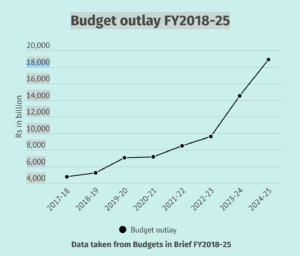
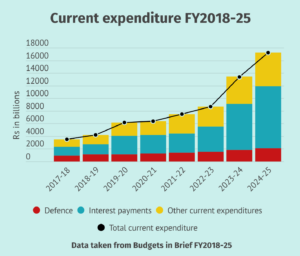
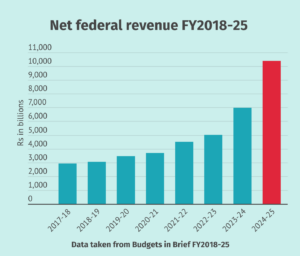
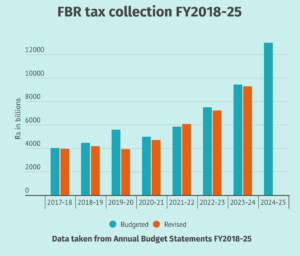
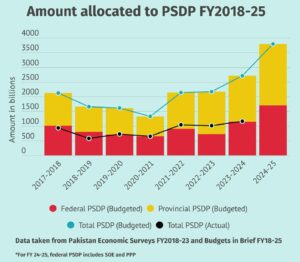
Reference:
Nadir Gurmani, Sanaullah Khan, Irfan Sadozai “Finance Minister Aurangzeb presents Rs18.9tr federal budget ‘in line with IMF guidelines’”(published June 12, 2024): https://www.dawn.com/news/1839433

